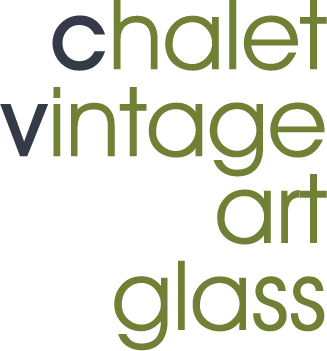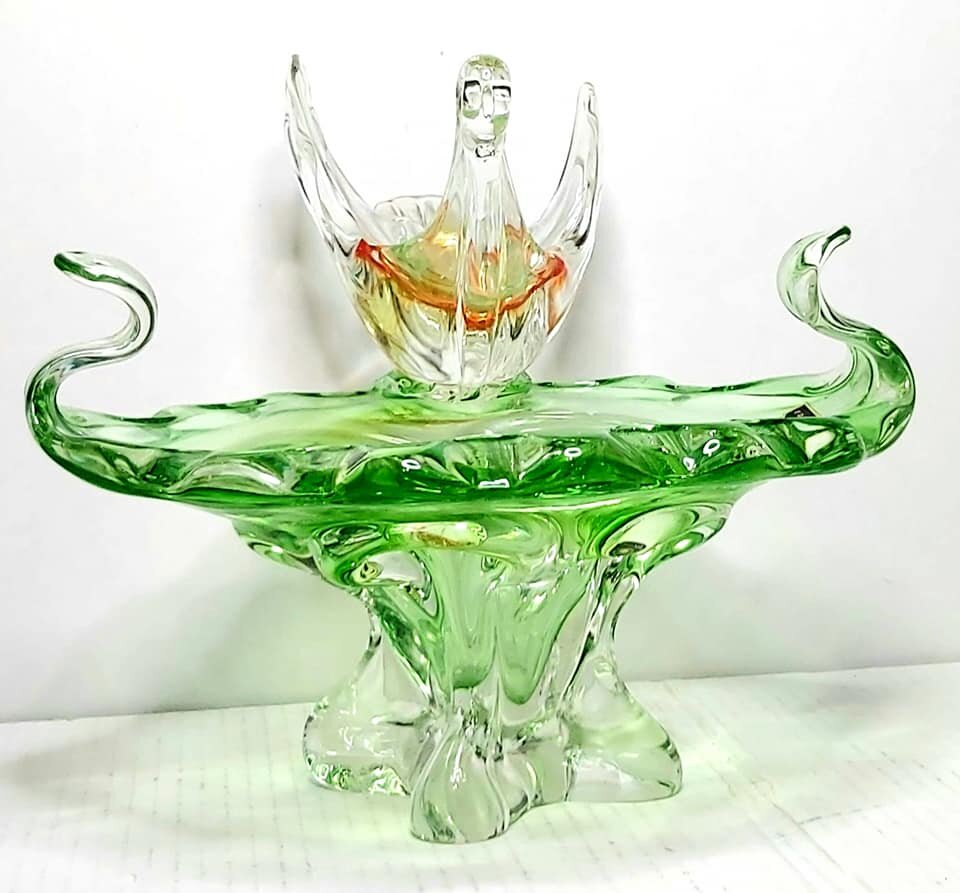More Conversations with the Artists
I recently took a “road trip” to Eastern Ontario – meeting both new friends and visiting some old. And of course – hunting in the Wild as we went from Toronto to Ottawa to Cornwall and home again.
The glass I got along the way. I kept one piece and passed the others along. The piece that I kept - a “unicorn” for me. I had been searching for it for years.
Meet “Mick”. It’s all in those lips! The Chalet horse. It was carried by Riekes Crisa - part of an animal assortment - catalogue listing #7439-69.
The whole trip was wonderful but there were 3 definite “bests”. The first of these being seeing where the Cornwall glasshouses were located on a tour with Paolo De Marchi . I saw the former locations of Chalet, Mosaic, Rossi, and Gala Glass.
September 12, 2021. My Chalet brick. I had found the tea a few days earlier in Ottawa and with a name like that - some had to come home with me!
A shared favourite piece. Both of us have memories of Chalet artist Gianfranco Guarnieri that the koala evokes.
The gang had a party too!
If that wasn’t enough – this was followed by dinner with his father Chalet artist Roberto De Marchi. The next morning, we had breakfast with Chalet Maestro Bruno Panizzon. Roberto first came to Canada from Murano to work at Lorraine Glass Industries in 1969. He then moved to Chalet and worked there from 1970 until its closure in 1975. Maestro Panizzon also came from Murano to work at Lorraine Glass Industries in 1962. He quickly moved to Chalet and worked there from 1962 until 1975. For detailed biographies regarding the “Faces of Chalet”, please see the article.
Chalet artist Roberto De Marchi. September 12, 2021.
Chalet Maestro Bruno Panizzon. September 13, 2021.
And, of course, Chalet was on both menus! Firstly, both artists signed my personal copy of “Chalet Crystal Clear” – brought back memories of them doing this at the exhibit and of my other books so that got us sidetracked. And we had a few more laughs – mostly about “Not Chalet.”
The exhibit was in Cornwall in 2010.
But we got back on course and went through “Chalet Crystal Clear” – they both have copies. We also went through all the Chalet catalogues and catalogue pages I have been able to get since last meeting with them. The conversation bounced all over the place. A lot of old points confirmed to make sure that I had not misunderstood or misrepresented any information they had shared years ago. And a lot of new details came up. These I want to share:
-both Bruno and Roberto once again confirmed that “Chalet did not do purple. Purple was a mistake.” And they once again stressed that not only are colour fluctuations between batches the norm but colour fluctuations within the same batch of mix are to be expected as well. This was most typically seen as the colour mix was used up – remaining colour was affected by conditions within the factory, length of time in vat and the lower the level. And the most common was that colour was being changed by impurities within the mixture - this grew more pronounced as time increased and levels decreased.
-they also spoke to the differences of weight, diameter, length and height and colour placement, casings… in the hand worked pieces. Differences indicate they are hand formed. If pieces are identical - they were from a mold. Some new collectors find the differences in detail confusing - thinking perhaps they indicate different glasshouses. Not so - differences in the same form are an indication of hand worked pieces. Something that Chalet was very proud of and they marketed their product under this banner extensively.
-Corning Glass (Corning, New York) made the majority of molds for the Chalet hand molded pieces. So, the connection to that company finally revealed! Roberto had actually gone there with Angelo Tedesco to pick up some molds and give a demonstration. Both artists also said that some of the molds for the tools they used were made in Cornwall by a local company. This company, however, did not make any of the glass molds.
-both artists confirmed that the molded mushroom was only made in one configuration. Unlike the molded owls which are made in 4 different sizes.
-neither artist remembers the clear crystal molded embossed owls. Therefore, the mystery regarding where these were made and by whom remains. See the chapter “Chalet and Don Shepherd” in “Chalet Crystal Clear” for the most likely scenarios.
All 4 configurations of the molded owls. From the collection of 50 Shades member Jo highland. Photograph courtesy of Jo Highland.
-both artists do, however remember the large Don Shepherd/Chalet bottles and vases being made at the Chalet factory. Maestro Panizzon said they were hand blown into molds – not hand formed or mouth blown pieces. These styles are also detailed in the “CCC” chapter mentioned above.
-neither artist remember the olive/blue divided forms. This means they were not on the teams producing them. I think very likely that these forms could have been made by Chalet Maestro and owner Luigi Tedesco. Chalet Maestro Giulio Gatto has since confirmed that he, as wee, has no knowledge of these forms nor of their making. this furthers my belief that they were likely to have been done by one of the owners.
-Roberto, like Bruno, does not remember the Chalet paperweights. Again, this means that neither were on team that created these forms. They would have been time consuming to produce as the coloured glass inclusions would have had to made earlier and in a separate process. IMPORTANT UPDATE: We know know who blew these pieces.
See article on paperweights for more photographs and details.
-Maestro Panizzon had a “Never say Never” moment when he saw the photograph on page 110 of “Chalet Crystal Clear” of this Chalet centerpiece. He would only accept that it was indeed a Chalet piece when I assured him it was a piece from my own collection and was etched with the ‘Chalet Canada’ signature
-the design of this piece led to a discussion of EDAG art glass. Maestro Panizzon expressed great admiration for EDAG Maestro Danilo Pavenello. He called him a “superb artist.” And he also said he admired that EDAG had done a lot of non-production work.
EDAG Maestro Danilo Pavenello. Circa 1970. Exact date unknown.
The 3 photos directly above are excellent examples of non-production work by Maestro Pavenello.
-a Lorraine Glass artist that Maestro Panizzon also thought of highly was Maestro Mario Cimarosto. This artist was also originally from Murano and returned there after Lorraine closed in 1974.
-Roberto had known and worked with Chalet Maestro Sergio Pagnin in Murano.
-Paolo Danesin, brother-in-law of Sergio Pagnin would bring the canna ‘bubble’ of molten glass from the oven to the artists to be worked.
At the Chalet factory. Date unknown. Foreground - Chalet owner and Maestro Luigi Tedesco. Background - Paolo Danesin. Photograph courtesy of Paolo De Marchi.
-Roberto and Bruno talked about who typically worked with whom. Bruno and Luigi Tedesco (Chalet owner and Maestro) worked together a lot. Gianfranco Guarnieri worked very regualrly with both Maestro Sergio Pagnin and artist Angelo Rossi. Giovanni Voltolina worked closely with Maestro Guilio Gatto. Roberto worked solo a lot with the bomboniere but also collaborated with Giovanni Voltolina and Maestro Guilio Gatto. Here is a Christmas tree that those 3 produced together – Roberto formed the ball base, Giovanni made the green core and Maestro Gatto “iced” the tree and ensured that the pulls were perfect. It then would have been sent to Chalet artist Antonio Tedesco for the base to be made smooth and polished and the branding applied. This tree retains its Chantili sticker. It has been in the possession of the De Marchi family since production.
Photograph courtesy of Paolo De Marchi.
It was an amazing trip! For more “Words from the Artists”, please see an earlier article as well.






















